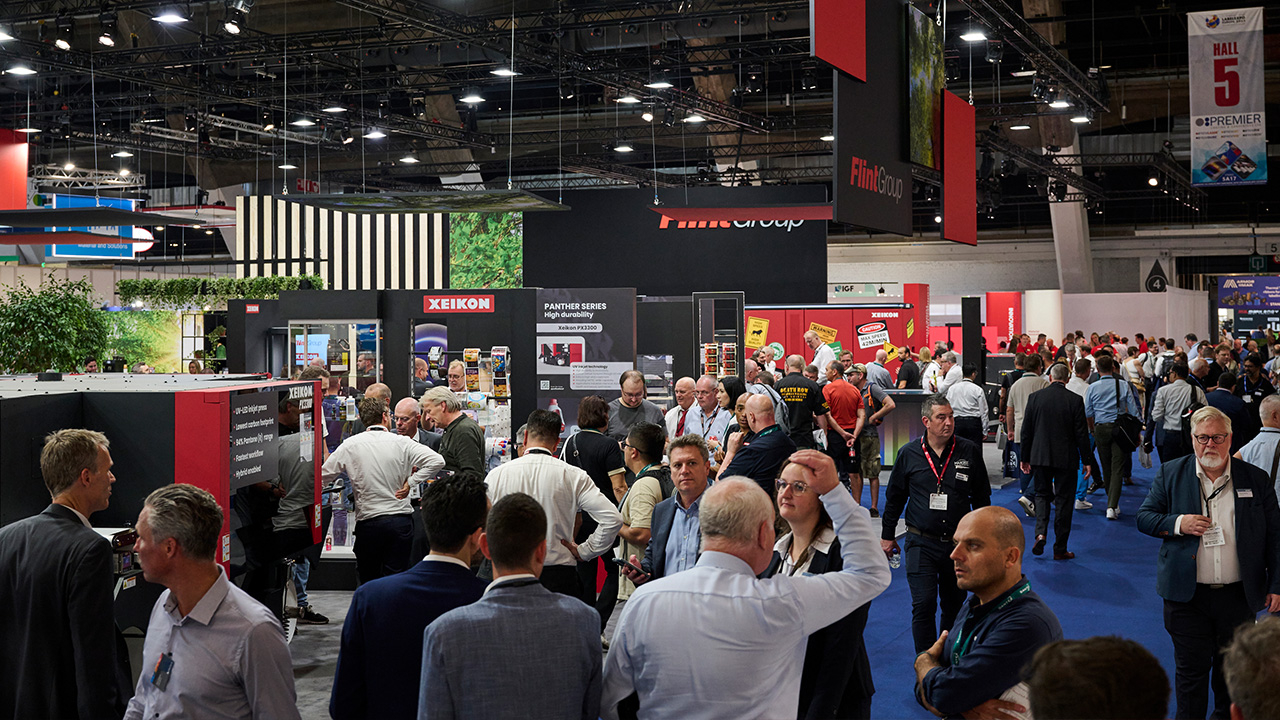The future of print quality and compliance monitoring
The label industry workflow of tomorrow will certainly be very different from today.

The past twenty-odd years have seen the label industry undergo a number of significant developments and changes in the way that labels are produced, and in the way converters work with their brand owner customer specification and compliance guidelines covering print quality and performance, barcode readability, RFID and NFC compliance, VR and AR usage ̶ and increasingly, as they start to look more and more at monitoring and compliance requirements in terms of sustainability, waste, recycling, CO2 and energy.
The challenge for label and packaging converters is that, while there are a lot of similarities in content between the different customer specification and compliance requirements for print quality, label performance, traceability and environmental performance, there are relatively few national or international guidelines or standards. This means that converters may often have to implement a different set of specifications, compliance and rules for each customer.
Major advances in pre-press, origination and color management ̶ combined with the latest flexo and offset press technology in terms of precision manufacturing, servo systems, automation and even moves into artificial intelligence for automated job set-up by streamlining pre-press to pressroom connectivity, plus initial press set-up and job repeatability ̶ have done much to take traditional label printing technology to new levels of output and printability, making it somewhat easier to meet different customer print specification and compliance requirements.
Automatic monitoring and correction
Combine that precision with ever-more sophisticated on-press inspection and camera systems that can detect color print and die-cut register problems, offer in-line color measurement, provide FOGRA color certification, monitor fine print detail, misprints, missing labels, text defects, spots and splashes, as well as provide barcode, RFID and NFC compliance and variable data checking. Many things that were manually corrected by a press operator in the past are now being automatically monitored, identified and corrected in-line on the press.
Certainly, with barcode errors being the number one cause of vendor compliance violations and chargeback penalties, barcode compliance is critical. The barcode ̶ or RFID, NFC or AR ̶ label needs to be 100 percent readable with the right symbology and in the right placement on the label, carton or pallet. Anything less may slow down packaging line, distribution and retail operations and cost money.
The challenge for label and packaging converters is that there are relatively few national or international guidelines or standards
More recently there have been innovations in the on-press monitoring of UV output to ensure that it is within the expected defined range and that under-cured labels, sleeves or flexible packaging do not reach the customer, as well as technology for the automatic set-up of a job for in-line color measurement and the generation of color scorecard reporting on color quality performance after printing. This integration delivers better visibility into color performance based on measurable, objective results for increased color consistency.
The rapid evolution of digital printing has also had a major impact on the label printing industry and the quality and services it can provide to brand owners and retailers. Smart digital front-ends (DFEs) for digital labels and packaging have transformed the role of the digital press in a new generation of smart factories. Again, 100 percent automatic inspection systems complement what can be produced on digital toner or inkjet presses by addressing issues such as ink drips, missing nozzles or other specific challenges ̶ all in real-time.
As label presses, whether analogue or digital, continue to integrate AI learning, the future label plant will undoubtedly experience more presses with closed loop controls that not only learn about print quality, code readability or compliance problems as they occur, but are also able to provide intelligent guidance to the operator on how to correct them ̶ or even correct or adjust any print faults or problems automatically, without any operator intervention.
Integration in the supply chain
Put all this sophisticated press, inspection and monitoring technology together with current and forecast developments in AI, automation, and MIS and we can begin to envisage how the label plant of tomorrow will likely increasingly integrate its automated workflow with label and packaging designers, substrate, ink, equipment and ancillary suppliers, with shipping and distribution suppliers, and with labeling systems technology at packers, co-packers and brand owners ̶ right through to issuing delivery notes, arranging delivery and, if required, providing print quality, label performance, barcode readability, CO2 and waste compliance documents or certification.
COP26 sent a clear message: measure your carbon footprint and instigate a plan to move towards net zero, or risk lagging behind competitors
Automation throughout the whole label supply chain will enable the delivery of consistent ̶ documented, compliant (and certified at each stage if necessary) ̶ error-free production, high employee efficiency and high-quality output, whether short, medium or long runs of labels and packaging. And all easily adapted to individual customer specifications, requirements and compliance documentation.
Looking forward, it’s not just label and packaging print quality and performance where retailers and brand owners will be looking to work with their suppliers. Today ̶ and increasingly over the coming years ̶ they will also have to be looking at many aspects of environmental performance and sustainability. Indeed, retailers and brand owners are already under increasing pressure to move to a product life-cycle approach to sustainability ̶ from consumers, environmental bodies and from governments.
Alongside the many pledges made by many governments (60 or more) at the recent COP26 in Glasgow, a central outcome was a clear shift in global momentum for businesses to move towards net zero ̶ and provide evidence that they are reducing their carbon footprint. However, this will mean that converters will need a formal system, data collection and measurable, specific metrics (such as ESG factors) to prove their case.
This adoption of net zero as a core organizing principle for business will leave any label or package converter without a comprehensive plan to move to a lower-carbon economy somewhat exposed, not only to retailer and brand-owner customers but with regards to various government regulations coming down the line. COP26 has sent a clear message to label and packaging converters: measure your carbon footprint and instigate a plan to move towards net zero, or risk lagging behind competitors.
Innovate for sustainable products and solutions
As more countries move to enforcing environmental legislation and extended producer responsibility policies, so retailers, brand owners and their chain of suppliers will need to innovate when it comes to sustainable products, their labeling and packaging, and to providing documentation and certification, as well as to enhancing relationships with consumers.
Retailers have also recognized that more and more consumers feel that it is important to limit the impact of climate change, with some retail groups starting to implement initiatives like social responsibility audits at their own and suppliers’ factories.
Over the next five or ten years the label and packaging converter will certainly become increasingly involved in lifecycle assessments, responsibility audits and the documentation of waste management programs, in chain of custody certification, in documenting of CO2 emissions and carbon footprints, in FSC or PEFC certification, in energy, waste and label reduction targets, and in CO2 emissions, recycling and other on-pack labeling schemes. The requirements for MIS and workflow systems that can provide documentation or certification to prove targets are being met will undoubtedly grow.
As sustainability pressures continue to take center stage, so leading retail groups are already using or moving towards carbon labeling across key brand and own-label products in some stores, while at Unilever for example, carbon labels will include energy used in production, processing and packaging. The company plans to reduce carbon emissions from its own ̶ and its suppliers' ̶ operations.
These various carbon labeling schemes promote a commitment to sourcing 100 percent of key raw materials from sustainable sources, as well as factors that include production methods, labels and packaging, and carbon footprint. Such schemes for the label converter may include confirmation, documentation or compliance with FSC or other sustainable label materials.
In other developments, and faced with increasing pressures on the amount of waste generated, many governments are reviewing available policy options and seem to have concluded that placing the responsibility for the post-consumer phase of certain goods on producers could be an option. Here, Extended Producer Responsibility (EPR) is a policy approach under which producers are given a significant responsibility – financial and/or physical – for the treatment or disposal of post-consumer products. Assigning such responsibility could in principle provide incentives to prevent waste at the source, promote product design for the environment and support the achievement of public recycling and materials management goals.
Indeed, there is already an establish policy approach for an Extended Producer Responsibility for Packaging that is increasingly being adopted by many countries around the world to help them meet their packaging waste recycling obligations and targets. This approach is aimed at giving packaging and label producers an incentive to make better, more sustainable decisions at the product design stage, including decisions that make it easier for products to be re-used or recycled at their end of life.
Some label industry suppliers have already expanded the International Sustainability and Carbon Certification Plus certification (ISCC) program to their production plants following significant interest in the potential of increasing their commitment to reducing CO2 emissions and adopting a circular economy model. For reference, ISCC is an independent multi-stakeholder organization providing a globally applicable certification system for the sustainability of raw materials and products.
Others What's becoming clear is that tomorrow's label and packaging converting plants will have increasingly complex workflow and print quality requirements, provide readability of track and trace technologies (codes, RFID, NFC), plus meet a host of environmental and sustainability requirements (lifecycle assessment, energy targets, CO2, water, documented waste management, biodegradability, recycling and re-use, chain of custody certification) and will increasingly make use of ever-more sophisticated MIS and artificial intelligence systems as they steadily head towards the (fully) automated factory of tomorrow.
Stay up to date
Subscribe to the free Label News newsletter and receive the latest content every week. We'll never share your email address.


